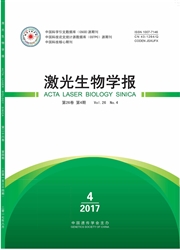

 中文摘要:
中文摘要:
细胞内肌动蛋白(actin)通过与actin结合蛋白(actin binding proteins,ABPs)相互作用,形成以F-actin为基础多种ABPs参与装配的高度有序的超分子聚合结构,行使各种最要生理功能。在体外聚合条件下,不存在F-actin稳定剂时纯化的actin主要通过自装配形成大尺度的聚集堆积结构;这种表观无序的结构体系由于被认为不具备细胞功能活性而受到忽视。利用激光原子力显微镜(atomic force microscope,AFM)和透射电子显微镜(transmission electron microscope,TEM)技术,对actin体外通过自装配过程形成的大尺度聚集结构进行了细致的观察和分析。研究发现,actin在体外通过自装配过程除了形成无序的蛋白堆积物之外,还能够聚合形成复杂的离散结构,包括树状分支的纤维丛、无规卷曲的纤维簇以及具有不同直径的长纤维等;这些大尺度纤维复合物明显不同于在ABPs或过量F-actin稳定剂参与下形成的由单根微丝和微丝束构成的聚合结构。表明无ABPs或F-actin稳定剂存在的情况下,体外聚合的F-actin在一定条件下可进一步聚集缠绕形成复杂的纤维结构或无序的蛋白堆积物。事实上,actin自装配过程反映了其固有的聚合热力学特性,深入探索将有助于理解ABPs在体内actin超分子聚合结构体系装配中的调控作用及其分子机制。
 英文摘要:
英文摘要:
Actin is capable of being assembled into ordered supra-molecular structures in living cells based on the combination between F-actin and actin binding proteins. It can also be polymerized into complexes by self-assembly in vitro which usually were recognized as seeming random aggregates different from those assembled in cells, which were thus ignored for quite a long time. In the present article, the laser atomic force microscope, a novel tool for surface structure exploration, and transmission electron microscope were employed to investigate the large-scale filamentous structures forming in actin self-assembly in vitro. It was demonstrated that the actin could be polymerized into discrete filaments of tree-like branch structure, random coil filaments cluster and long filaments with different diameters in F-buffer besides random aggregates. These polymerized filaments clearly exhibited the structural polymorphism and showed obvious difference from those assembled under the regulation by actin binding proteins or phalloidin. It was indicated that the dynamic equilibrium of actin polymerization/depolymerization and the native conformation of F-actin were possibly responsible for the emergence of large-scale filamentous structures by self-assembly in vitro, which in fact reflected the inherited features of actin dynamics. In-depth investigation on actin self-assembly in vitro would be helpful to understand the roles of actin binding proteins in the regulation on the actin supra-molecular structures assembly in cells.
 同期刊论文项目
同期刊论文项目
 同项目期刊论文
同项目期刊论文
 期刊信息
期刊信息
